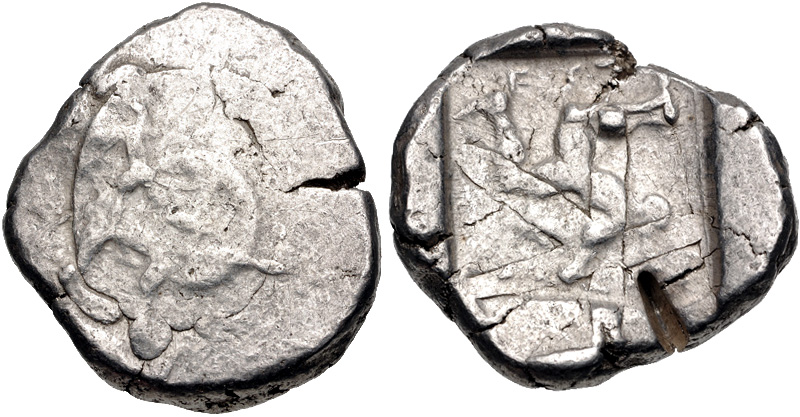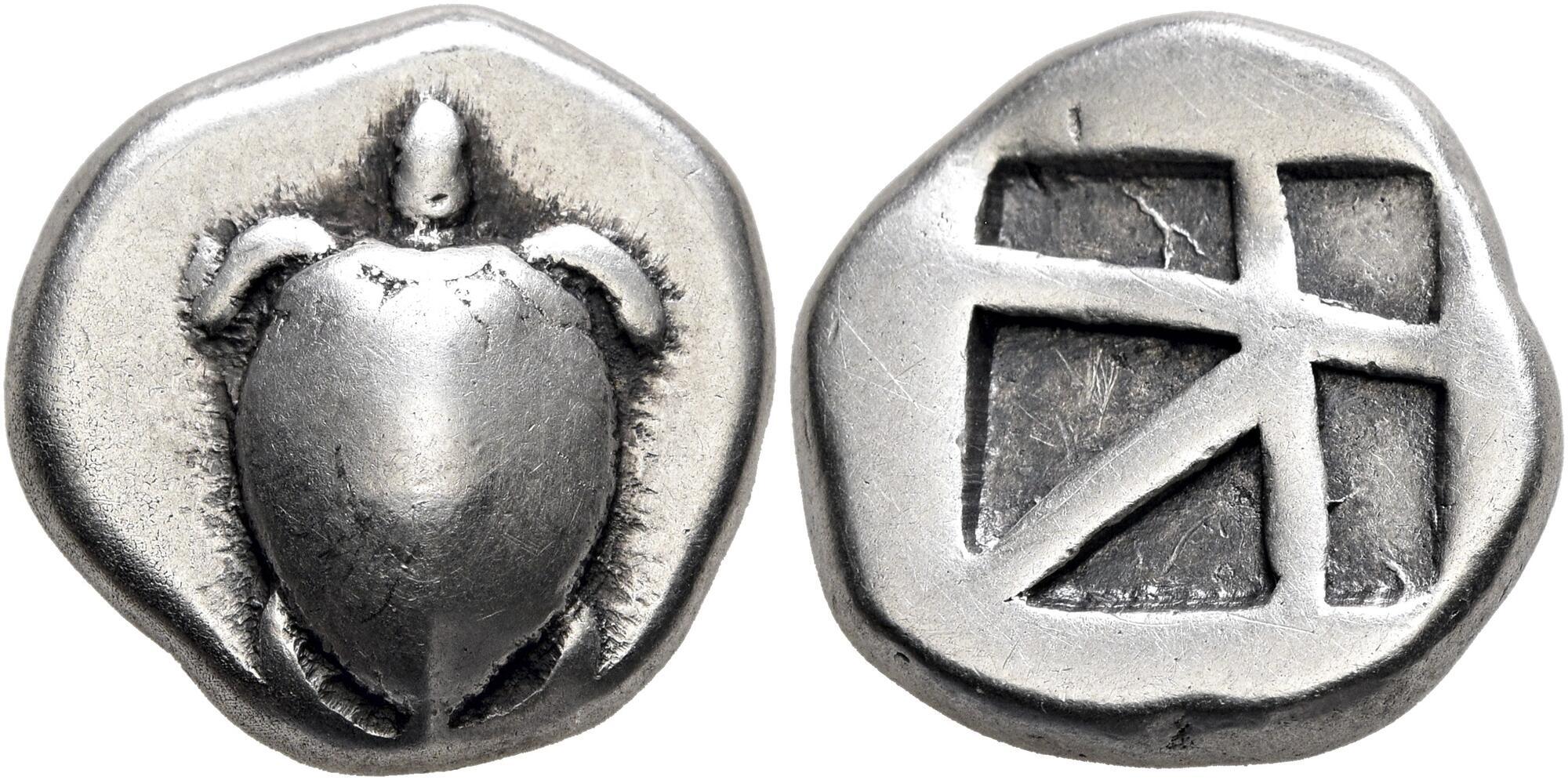2452 - Aspendus (double siglos hoplite/triskeles) over Aegina (turtle/incuse square) (CNG, EA 440, March 2019, 173): Difference between revisions
From SILVER
No edit summary |
No edit summary |
||
| Line 12: | Line 12: | ||
|Ancient region=Pamphylia | |Ancient region=Pamphylia | ||
|Authority=Persian Empire | |Authority=Persian Empire | ||
|Date from= | |Date from=465 BCE | ||
|Date to=430 BCE | |Date to=430 BCE | ||
|Period=Classical | |Period=Classical | ||
| Line 23: | Line 23: | ||
|Coin series reference=Babelon 1901, Part 2, Tome 1, p. 526-530, n° 869-70 ; SNG von Aulock Pamphylien, n° 4482-83 ; SNG France 3, n° 12-13 | |Coin series reference=Babelon 1901, Part 2, Tome 1, p. 526-530, n° 869-70 ; SNG von Aulock Pamphylien, n° 4482-83 ; SNG France 3, n° 12-13 | ||
|Coin series web reference=https://greekcoinage.org/iris/id/aspendus_babelon_1907_869-70 | |Coin series web reference=https://greekcoinage.org/iris/id/aspendus_babelon_1907_869-70 | ||
|Overstruck obverse description=Sea turtle | |Overstruck obverse description=Sea turtle | ||
|Overstruck reverse description= | |Overstruck reverse description=Incuse square with skew pattern | ||
|Overstruck mint=Aegina | |Overstruck mint=Aegina | ||
|Overstruck ancient region= | |Overstruck ancient region=Attica | ||
|Overstruck date from=480 BCE | |Overstruck date from=480 BCE | ||
|Overstruck date to=457 BCE | |Overstruck date to=457 BCE | ||
Revision as of 04:54, 30 July 2023
465 BCE - 430 BCE | ΕΣΤ
Location/history
| Sale(s)Sale(s) ᵖ: | Classical Numismatic Group, EA 440, 20 March 2019, 173 | |
Overstriking coin
Description
| ObverseInscription or printing placed on the obverse.: | Warrior walking right, naked, wearing helmet, holding spear in right hand, shield attached on left arm. | ReverseInscription or printing placed on the reverse.: | ΕΣΤ (Greek) Triskeles of human legs within incuse square. |
Mint and issuing power
| MintIdentifies the place of manufacture or issue of a numismatic object.: | Aspendus | Ancient regionAncient region. | Pamphylia | Modern countryModern country: Turkey | AuthorityIdentifies the issuing power. The authority can be "pretended" when the name or the portrait of X is on the coin but he/she was not the issuing power. It can also be "uncertain" when there is no mention of X on the coin but he/she was the issuing power according to the historical sources: | Persian Empire |
Chronology
| FromIdentifies the initial date in a range assigned in a numismatic context. 465 BCE toIdentifies the final date in a range assigned in a numismatic context.. 430 BCE | Classical 480-323 BC |
Physical description
| MetalThe physical material (usually metal) from which an object is made.: Silver |
WeightWeight of the numismatic object (in grams). in grams: 10.910.9 g <br />10,900 mg <br /> | DenominationTerm indicating the value of a numismatic object. Examples: tetradrachm, chalkous, denarius.: double siglos |
AxisDescribes the directional relationship between the obverse and reverse of a numismatic object.: 99 mm <br />0.9 cm <br /> |
| DiameterDescribes diameter of an object (in mm).: 2121 mm <br />2.1 cm <br /> | StandardStandard.: Persian | ||
References
| Coin referenceReference of the Coin: | Coin series referenceReference to coin series study: | Babelon 19011Babelon 1901, Part 2, Tome 1, p. 526-530, n° 869-70, SNG von Aulock Pamphylien2SNG von Aulock Pamphylien, n° 4482-83, SNG France 33SNG France 3, n° 12-13 | |
| Coin series web referenceCoin series web references: | |||
Overstruck type
Description
| ObverseInscription or printing placed on the obverse.: | Sea turtle | ReverseInscription or printing placed on the reverse.: | Incuse square with skew pattern |
Mint and issuing power
| MintIdentifies the place of manufacture or issue of a numismatic object. ᵖ: | Aegina | Ancient regionAncient region. ᵖ | Attica | Modern countryModern country: Greece | AuthorityIdentifies the authority in whose name (explicitly or implicitly) a numismatic object was issued. ᵖ: |
Chronology
| FromIdentifies the initial date in a range assigned in a numismatic context. 480 BCE toIdentifies the final date in a range assigned in a numismatic context.. 457 BCE | Archaic until 480 BC |
Physical description
| DenominationTerm indicating the value of a numismatic object. Examples: tetradrachm, chalkous, denarius. ᵖ: | stater |
StandardStandard. ᵖ: | Aeginetic |
References
| Coin type referenceReference to coin series study ᵖ: | HGC 64HGC 6, n° 435, Meadows (forthcoming)5Meadows (forthcoming), Groups IIa-IIb | ||
| Coin series web reference overstruckCoin series web references overstruck: | |||
Additional data
| Frequency of overstrikesFrequency of overstrikes: | frequent | Level of confidenceLevel of confidence of the identification: | sure |
| RemarksRemarks: | "Overstruck on a stater of Aegina (cf. HGC 6, 435 for type)" | ||
References
- ^ Babelon, Ernest (1901), Traité des monnaies grecques et romaines. Tome Premier. Première partie, théorie et doctrine, Paris, E. Leroux
- ^ Sylloge Nummorum Graecorum. Sammlung v. Aulock. Pamphylien. 11 Heft (n° 4477-4893), Berlin, 1965.
- ^ Levante, Edoardo [with the collaboration of Peter Weiss] (2001), Sylloge nummorum graecorum. France. 3, Département des monnaies, médailles et antiques : Pamphylie, Pisidie, Lyaconie, Galatie, Paris-Zürich, Bibliothèque nationale de France-Numismatica Ars Classica, XXXIV + 293 p. and 146 pl.
- ^ Hoover, Oliver D. (2010), The Handbook of Greek Coinage Series, volume 6 : handbook of coins of the islands: Adriatic, Iionian, Thracian, Aegean, and Carpathian seas (excluding Crete and Cyprus), sixth to first centuries BC, Lancaster, 358 p.
- ^ Meadows, Andrew (forthcoming), Greek coinage in the Persian Empire: The Malayer 1934 Hoard (IGCH 1790).

